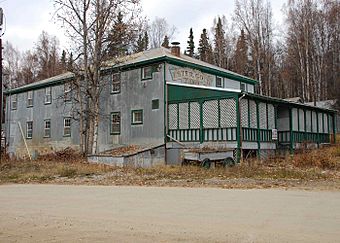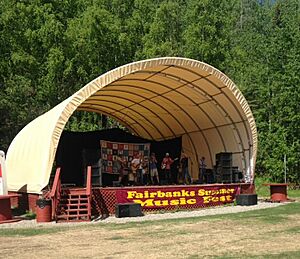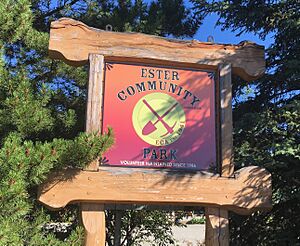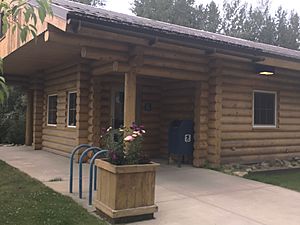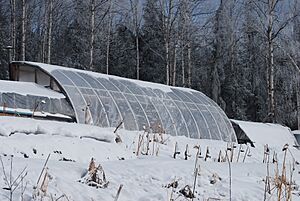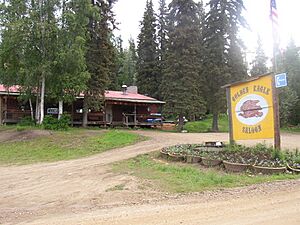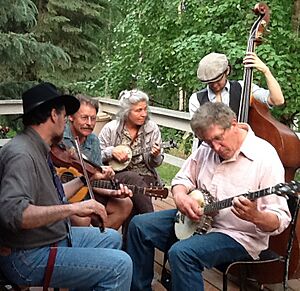Ester, Alaska facts for kids
Quick facts for kids
Ester, Alaska
|
|
|---|---|
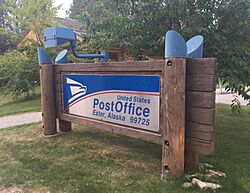
The United States Post Office in Ester, Alaska
|
|
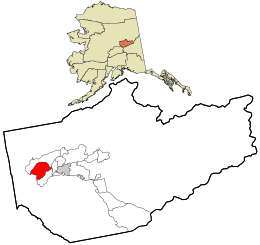
Location within Fairbanks North Star Borough and the state of Alaska
|
|
| Country | United States |
| State | Alaska |
| Borough | Fairbanks North Star |
| Area | |
| • Total | 64.30 sq mi (166.55 km2) |
| • Land | 64.24 sq mi (166.37 km2) |
| • Water | 0.07 sq mi (0.17 km2) |
| Elevation | 722 ft (220 m) |
| Population
(2020)
|
|
| • Total | 2,416 |
| • Density | 37.61/sq mi (14.52/km2) |
| Time zone | UTC-9 (Alaska (AKST)) |
| • Summer (DST) | UTC-8 (AKDT) |
| ZIP code |
99725
|
| Area code(s) | 907 |
| FIPS code | 02-23460 |
| GNIS feature ID | 1397658 |
Ester is a small community in Alaska, United States. It's known as a census-designated place (CDP) within the Fairbanks North Star Borough. Ester is part of the larger Fairbanks, Alaska area. In 2020, about 2,416 people lived here.
Ester started as a gold mining camp in the early 1900s. Mining and services for miners have always been important to its economy. Today, Ester has a volunteer fire department, a library, a historical society, and a post office. Many artists, writers, and musicians also call Ester home. The Ester Camp Historic District is a special area listed on the National Register of Historic Places.
Contents
Discovering Ester's Past
Ancient Animal Discoveries
When miners used powerful water jets to find gold in Ester, they also uncovered something amazing. They found many fossils and bones of prehistoric animals! In the 1950s, a miner named Walter Wigger found a huge 198-pound mammoth tusk near Ester Creek. Old photos from the 1940s show other remains, like tusks, skulls, and large leg bones. These were all washed out by the mining process.
Ester's Gold Rush Beginnings
Ester began as a gold mining camp on Ester Creek. The first official claim was made in February 1903. However, an independent miner named John "Jack" Mihalcik was the first to actually find gold there in November 1903. News of his discovery spread in February 1904.
By 1907, Ester City had about 200 people. The mining industry was booming! A social hall was built in 1907, famous for its dance floor. This hall was used for everything from religious services to dances, movies, and card games. The town also had five saloons and two hotels. By 1909, Ester City even had a baseball field, a doctor, and a teacher. However, gold production started to slow down.
Changes and Growth Over Time
In 1910, the Berry Post Office moved into Ester. It kept the name "Berry" until 1965, when it finally became the Ester Post Office. In the mid-1920s, the Fairbanks Exploration Company (F.E. Company) bought many mining claims. They started big operations in 1929. In 1933, they built a large mess hall for their camp. These buildings are now a historic landmark.
The F.E. Company brought new life to the town. They used huge floating dredges and draglines for large-scale open-pit mining. This process changed much of the original Berry and Ester areas.
Ester Since the 1940s
The Ester Community Association was formed in 1941. In 1958, the F.E. Company sold its Ester camp. It reopened as a historic resort called Cripple Creek Resort, later known as Ester Gold Camp. This resort had a fun musical show and a local bar called the Malemute Saloon. The resort closed in 2007, but the Malemute Saloon still opens on some summer weekends for live music.
In 1974, the Ester Volunteer Fire Department officially started. Gold mining continued on a smaller scale. In 1986, the Ester Community Association and the Fairbanks North Star Borough built the Ester Community Park. This park became a popular spot for local activities. In 2017, the community association bought the park.
In 1987, eleven old buildings from the F.E. Company's camp were recognized as historic places.
In 1988, Mushing magazine started in Ester. The town also hosted the Fireplug Sled Dog Race for ten years. Many famous mushers, like Jeff King, competed. In 1999, Ester got its first newspaper, The Ester Republic. The John Trigg Ester Library (JTEL) opened in August 1999. It was named after a local resident who started a book exchange. Today, Ester has two saloons, several publishers, a library, a community hall, a post office, and many artists. There are also three active gold mines.
The Ester Historic Society was founded in 2018. It collects old photos, letters, and documents from local residents. The society and the library often host talks about Ester's history.
Ester's Location and Features
Ester is located at 64°51′21″N 147°58′42″W / 64.85583°N 147.97833°W. The area covers about 166.5 square kilometers (64.3 square miles). Most of this is land, with a small amount of water.
Ester Community Park
Ester has a popular park that is cared for by volunteers. The park has an ice rink that turns into a basketball court in the summer. It also has a playground, a picnic area, a stage, and a soccer field. The park is next to the Ester Volunteer Fire Department. It hosts many events like soccer games, football games, and the Fourth of July picnic. In the summer, there's a farmers' market where local farmers sell their produce.
The Village Square
Ester village is built around a central square. This "town square" is actually the parking lot of the Golden Eagle Saloon. It's divided by Main Street but acts as a main gathering spot for celebrations like Fourth of July and New Year's Eve. Homes, the John Trigg Ester Library, and the Golden Eagle Saloon surround the square.
Mining Tailings
Because of all the mining in the past, Ester is surrounded by piles of gravel and dirt called tailings.
Ester's Climate
Ester has a subarctic climate. This means it has very cold, long winters and short, mild summers.
| Climate data for Ester, Alaska, 1991–2020 normals, extremes 1997–present | |||||||||||||
|---|---|---|---|---|---|---|---|---|---|---|---|---|---|
| Month | Jan | Feb | Mar | Apr | May | Jun | Jul | Aug | Sep | Oct | Nov | Dec | Year |
| Record high °F (°C) | 50 (10) |
46 (8) |
60 (16) |
77 (25) |
87 (31) |
92 (33) |
91 (33) |
92 (33) |
76 (24) |
74 (23) |
42 (6) |
39 (4) |
92 (33) |
| Mean maximum °F (°C) | 26.1 (−3.3) |
36.2 (2.3) |
46.9 (8.3) |
60.7 (15.9) |
80.1 (26.7) |
85.4 (29.7) |
86.5 (30.3) |
80.2 (26.8) |
70.1 (21.2) |
56.3 (13.5) |
29.3 (−1.5) |
27.6 (−2.4) |
87.8 (31.0) |
| Mean daily maximum °F (°C) | −0.3 (−17.9) |
11.0 (−11.7) |
25.2 (−3.8) |
44.9 (7.2) |
61.2 (16.2) |
71.0 (21.7) |
71.9 (22.2) |
64.9 (18.3) |
54.2 (12.3) |
33.4 (0.8) |
11.2 (−11.6) |
3.2 (−16.0) |
37.6 (3.1) |
| Daily mean °F (°C) | −7.7 (−22.1) |
0.7 (−17.4) |
10.3 (−12.1) |
31.6 (−0.2) |
47.6 (8.7) |
58.1 (14.5) |
60.5 (15.8) |
54.1 (12.3) |
42.8 (6.0) |
24.4 (−4.2) |
3.2 (−16.0) |
−4.2 (−20.1) |
26.8 (−2.9) |
| Mean daily minimum °F (°C) | −15.0 (−26.1) |
−9.7 (−23.2) |
−4.6 (−20.3) |
18.3 (−7.6) |
34.1 (1.2) |
45.3 (7.4) |
49.2 (9.6) |
43.4 (6.3) |
31.3 (−0.4) |
15.4 (−9.2) |
−4.7 (−20.4) |
−11.6 (−24.2) |
16.0 (−8.9) |
| Mean minimum °F (°C) | −43.8 (−42.1) |
−39.0 (−39.4) |
−31.7 (−35.4) |
−6.6 (−21.4) |
19.1 (−7.2) |
29.7 (−1.3) |
34.1 (1.2) |
27.3 (−2.6) |
15.5 (−9.2) |
−7.4 (−21.9) |
−29.5 (−34.2) |
−35.9 (−37.7) |
−45.4 (−43.0) |
| Record low °F (°C) | −55 (−48) |
−58 (−50) |
−43 (−42) |
−32 (−36) |
9 (−13) |
24 (−4) |
27 (−3) |
23 (−5) |
0 (−18) |
−20 (−29) |
−42 (−41) |
−52 (−47) |
−58 (−50) |
| Average precipitation inches (mm) | 0.67 (17) |
0.61 (15) |
0.53 (13) |
0.41 (10) |
0.68 (17) |
2.08 (53) |
2.70 (69) |
2.83 (72) |
1.51 (38) |
0.89 (23) |
0.89 (23) |
0.75 (19) |
14.55 (370) |
| Source: NOAA (mean maxima/minima 2006–2020) | |||||||||||||
Ester's Economy and Community Life
Many Ester residents work in Fairbanks or at the University of Alaska Fairbanks. However, Ester also has many small businesses and self-employed people. The biggest employers in Ester are seasonal, like local mines. Fairbanks helps Ester's economy by providing a market for its products and services. Because Fairbanks has large stores and fast food, Ester has kept its unique mining village feel. This is important for tourism, as visitors enjoy the historic gold camp buildings.
After the Ester Gold Camp resort closed in 2007, a group of local business owners formed the EMCE (Ester Ministry of Community Enterprise). This group supports Ester businesses and craftspeople. They sometimes host a local farmers' market and a "Planting Day" to make the village look nice.
Ester's Population Over Time
| Historical population | |||
|---|---|---|---|
| Census | Pop. | %± | |
| 1910 | 213 | — | |
| 1940 | 218 | — | |
| 1950 | 74 | −66.1% | |
| 1960 | 81 | 9.5% | |
| 1970 | 264 | 225.9% | |
| 1980 | 149 | −43.6% | |
| 1990 | 147 | −1.3% | |
| 2000 | 1,680 | 1,042.9% | |
| 2010 | 2,422 | 44.2% | |
| 2020 | 2,416 | −0.2% | |
| U.S. Decennial Census | |||
Ester first appeared in the 1910 U.S. Census. It has been counted in every census since 1940. In 1980, it became a census-designated place (CDP).
2010 Census Snapshot
In 2010, there were 2,422 people living in Ester. There were 1,069 households. About 84.6% of the people were White, 6.7% were Alaska Native or Native American, and 2.1% were Black or African American. About 3.3% of the population was Hispanic or Latino.
About 18.8% of the population was under 18 years old. The average age was 35 years. For every 100 females, there were about 120 males.
Famous People from Ester
- Clarence Berry was a very successful miner who lived near Ester. His mine was one of the largest and most successful in the early days of Ester.
- Richard A. Fineberg is a journalist who lives in Ester. He writes about oil development and environmental issues in Alaska.
- Magnus Colcord "Rusty" Heurlin (1895–1986) was a painter. He moved to Ester in 1924 and lived there until he passed away. He was known for his beautiful paintings of Alaskan skies.
- Eleanor Loback Garwood (1919-1989), also known as Ida Lane Clausen, was a popular performer at the Malemute Saloon. She played piano, sang, danced, and wrote for the Fairbanks News-Miner.
Wildlife in Ester
Ester is surrounded by boreal forests, which are like northern evergreen forests. This means you can often see many animals here!
- Mammals: moose, ermine (a type of weasel), snowshoe hare, foxes (including black, red, and cross foxes), least shrew, lynx, American red squirrel, porcupine, and red-backed vole. Sometimes, coyotes and black bears visit. Wolves are also seen occasionally.
- Birds: Many bird species live here, such as black capped chickadee, boreal chickadee, hawk owl, cliff swallow, hairy woodpecker, spruce grouse, ruffed grouse, ruby-crowned kinglet, trumpeter swan, Canada jay, raven, and pine grosbeak. Different types of owls, like the great horned owl, boreal owl, and great grey owl, also live in the area.
- Insects: Common insects include many kinds of bumblebees, hornets, yellow jackets, and wasps. Butterflies like the Canadian swallowtail and mourning cloak are also seen. You might also spot damselflies, dragonflies, and different types of moths. There are over 35 kinds of mosquitoes, some appearing as early as April!
Ester's Unique Culture
Farming and Food Gathering
In Alaska, fishing, hunting, and gathering food are important activities for fun and for getting food. Ester is no different! Many residents fish or hunt. Picking berries and mushrooms is a regular seasonal activity. Gardening has always been a part of Ester's culture. Farming has become more popular since 2000, with places like Calypso Farm & Ecology Center starting up. The Ester library even has a seed library program.
Artistic Community
Ester has a lively art community. Many painters, photographers, sculptors, and woodworkers live here. Since 2000, Ester has hosted an annual "BiPolar Art Show" with a gallery in Antarctica! There are also commercial galleries and private studios where artists sell their work.
Mining's Lasting Impact
Mining has been the main reason Ester exists for most of its history, and it's still important to the culture. You can find old mining equipment in the forests around the village. Some of these old parts have even been turned into art! The Malemute Saloon's show often celebrates the town's mining history. Ester Dome still attracts large mining companies, and several small gold mines provide jobs for residents.
Vibrant Music Scene
Ester has a strong local music culture. It hosts several music festivals each year, including:
- Angry Young & Poor (AYP), a free concert for young people.
- The Fairbanks Summer Folk Fest, a long-running folk festival.
- The LiBerry Music Festival & Pie Throwdown, a fundraiser for the library.
- Ester Fest, a family-friendly music fundraiser for the Ester Community Park.
There's also an old-time string band gathering called the Ester Jelly Jam. A local group, the Lost Dog Old-Time String Band, hosts monthly square and contra dances. You can often find impromptu music jams on saloon porches in the summer and every Sunday in the winter.
The Fourth of July Parade
The Ester Community Association organizes an annual Fourth of July parade. It starts in the village square and goes past the post office to the Ester Community Park. The parade features giant puppets, a children's bike parade, funny floats, old cars, and dancing. The Ester Volunteer Fire Department often participates. People from Calypso Farm throw vegetables to the crowd, and politicians hand out candy. Lady Liberty and Uncle Sam usually join the parade. The Red Hackle Pipe Band, a local group playing Scottish bagpipes, traditionally starts the parade. After the parade, there's a community potluck with a pig roast, live music, and games. A local water business sprays water on people to help them cool off.
See also
 In Spanish: Ester (Alaska) para niños
In Spanish: Ester (Alaska) para niños


